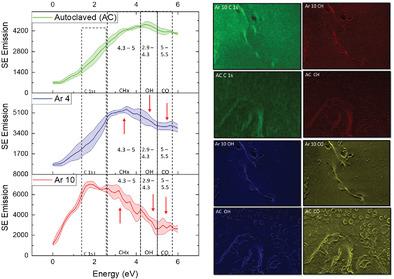Our official English website, www.x-mol.net, welcomes your
feedback! (Note: you will need to create a separate account there.)
Understanding Surface Modifications Induced via Argon Plasma Treatment through Secondary Electron Hyperspectral Imaging
Advanced Science ( IF 14.3 ) Pub Date : 2021-01-04 , DOI: 10.1002/advs.202003762 Nicholas Farr 1, 2 , Jeerawan Thanarak 1, 2 , Jan Schäfer 3 , Antje Quade 3 , Frederik Claeyssens 1, 2 , Nicola Green 1, 2 , Cornelia Rodenburg 1
Advanced Science ( IF 14.3 ) Pub Date : 2021-01-04 , DOI: 10.1002/advs.202003762 Nicholas Farr 1, 2 , Jeerawan Thanarak 1, 2 , Jan Schäfer 3 , Antje Quade 3 , Frederik Claeyssens 1, 2 , Nicola Green 1, 2 , Cornelia Rodenburg 1
Affiliation

|
Understanding the effects that sterilization methods have on the surface of a biomaterial is a prerequisite for clinical deployment. Sterilization causes alterations in a material's surface chemistry and surface structures that can result in significant changes to its cellular response. Here we compare surfaces resulting from the application of the industry standard autoclave sterilisation to that of surfaces resulting from the use of low‐pressure Argon glow discharge within a novel gas permeable packaging method in order to explore a potential new biomaterial sterilisation method. Material surfaces are assessed by applying secondary electron hyperspectral imaging (SEHI). SEHI is a novel low‐voltage scanning electron microscopy based characterization technique that, in addition to capturing topographical images, also provides nanoscale resolution chemical maps by utilizing the energy distribution of emitted secondary electrons. Here, SEHI maps are exploited to assess the lateral distributions of diverse functional groups that are effected by the sterilization treatments. This information combined with a range of conventional surface analysis techniques and a cellular metabolic activity assay reveals persuasive reasons as to why low‐pressure argon glow discharge should be considered for further optimization as a potential terminal sterilization method for PGS‐M, a functionalized form of poly(glycerol sebacate) (PGS).
中文翻译:

通过二次电子高光谱成像了解氩等离子体处理引起的表面改性
了解灭菌方法对生物材料表面的影响是临床部署的先决条件。灭菌会导致材料的表面化学和表面结构发生变化,从而导致其细胞反应发生显着变化。在这里,我们将应用行业标准高压灭菌器灭菌产生的表面与在新型透气包装方法中使用低压氩辉光放电产生的表面进行比较,以探索一种潜在的新生物材料灭菌方法。通过应用二次电子高光谱成像 (SEHI) 来评估材料表面。 SEHI 是一种基于低压扫描电子显微镜的新型表征技术,除了捕获形貌图像外,还通过利用发射的二次电子的能量分布提供纳米级分辨率的化学图。在这里,SEHI 图用于评估受灭菌处理影响的不同官能团的横向分布。这些信息与一系列传统的表面分析技术和细胞代谢活性测定相结合,揭示了为什么低压氩辉光放电应考虑进一步优化作为 PGS-M(一种功能化形式的 PGS-M)的潜在终端灭菌方法的有说服力的原因。聚(癸二酸甘油酯)(PGS)。
更新日期:2021-02-17
中文翻译:

通过二次电子高光谱成像了解氩等离子体处理引起的表面改性
了解灭菌方法对生物材料表面的影响是临床部署的先决条件。灭菌会导致材料的表面化学和表面结构发生变化,从而导致其细胞反应发生显着变化。在这里,我们将应用行业标准高压灭菌器灭菌产生的表面与在新型透气包装方法中使用低压氩辉光放电产生的表面进行比较,以探索一种潜在的新生物材料灭菌方法。通过应用二次电子高光谱成像 (SEHI) 来评估材料表面。 SEHI 是一种基于低压扫描电子显微镜的新型表征技术,除了捕获形貌图像外,还通过利用发射的二次电子的能量分布提供纳米级分辨率的化学图。在这里,SEHI 图用于评估受灭菌处理影响的不同官能团的横向分布。这些信息与一系列传统的表面分析技术和细胞代谢活性测定相结合,揭示了为什么低压氩辉光放电应考虑进一步优化作为 PGS-M(一种功能化形式的 PGS-M)的潜在终端灭菌方法的有说服力的原因。聚(癸二酸甘油酯)(PGS)。











































 京公网安备 11010802027423号
京公网安备 11010802027423号